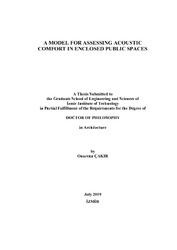Please use this identifier to cite or link to this item:
https://hdl.handle.net/11147/7363Full metadata record
| DC Field | Value | Language |
|---|---|---|
| dc.contributor.advisor | İlal, Mustafa Emre | |
| dc.contributor.author | Çakır, Onurcan | - |
| dc.date.accessioned | 2019-11-15T11:50:44Z | |
| dc.date.available | 2019-11-15T11:50:44Z | |
| dc.date.issued | 2019-07 | en_US |
| dc.identifier.citation | Çakır, O. (2019). A model for assessing acoustic comfort in enclosed public spaces. Unpublished doctoral dissertation, Izmir Institute of Technology, Izmir, Turkey | en_US |
| dc.identifier.uri | https://hdl.handle.net/11147/7363 | |
| dc.description | Thesis (Doctoral)--Izmir Institute of Technology, Architecture, Izmir, 2019 | en_US |
| dc.description | Includes bibliographical references (leaves: 91-97) | en_US |
| dc.description | Text in English; Abstract: Turkish and English | en_US |
| dc.description.abstract | Acoustic comfort is one of the important topics in terms of user satisfaction. In order to determine and control acoustic comfort, measurable parameters are needed to be able to compare and improve soundscapes. Parameters for architectural acoustics, like reverberation time and sound pressure level are widely used for this purpose. Psychoacoustic parameters like loudness, sharpness, roughness and fluctuation strength are mostly used for determining the sound quality of mechanical sounds. They have also started to be used for evaluating soundscapes of open areas and enclosed spaces. This research aims to find out the relationship between the psychoacoustic parameters and acoustic comfort in non-acoustic enclosed public spaces, specifically in eating establishments. To reach this aim, both on-site measurements and in laboratory listening tests were conducted in five eating establishments. During on-site measurements, a simultaneous questionnaire study was also conducted. Subjective and objective data were comparatively evaluated. Listening tests were based on auralizations with calibrated simulation models. This provided a research model, that allows control over the acoustic environment without having to make real changes in the physical elements of the eating establishments. The auralization sound files were presented to listening test participants with headphones and they evaluated soundscapes with different psychoacoustic properties. The last chapter provides a summary of results and suggestions for future studies. Better acoustic comfort was found to be related with higher sharpness, lower reverberation time, lower loudness and lower roughness values for the examined parameter ranges. | en_US |
| dc.description.abstract | Mekanların değerlendirilmesinde kullanıcı memnuniyeti göz önünde bulundurulduğunda, akustik konfor önemli konu başlıklarından biridir. Akustik konforu değerlendirebilmek ve iyileştirmek adına değerlendirebilmek için, ölçülebilir parametrelere ihtiyaç vardır. Reverberasyon süresi ve ses basınç düzeyi gibi mimari akustik parametreler, bu amaç için sıklıkla kullanılmaktadır. Gürlük, keskinlik, kabalık ve dalgalanım kuvveti gibi psikoakustik parametreler ise genellikle mekanik cihazların ses kalitelerinin değerlendirilmelerinde kullanılmaktadır. Bu parametreler aynı zamanda kapalı ve açık mekanların akustik konfor değerlendirmelerinde de kullanılmaya başlamışlardır. Bu çalışmanın amacı, yemek mekanları özelinde, akustik amaçlı kullanılmayan kapalı kamusal alanlarda akustik konfor değerlendirmeleri ile psikoakustik parametrelerin ilişkisini araştırmaktır. Bu amaca ulaşmak için, beş yemek mekanında yerinde ölçümler ve laboratuvarda işitme testleri gerçekleştirilmiştir. Yemek mekanlarında ölçümlerle eş zamanlı olarak anketler yapılmıştır. Ortaya konan nesnel ve öznel veriler karşılaştırmalı olarak değerlendirilmiştir. Bunun yanında, bilgisayarda benzetim yoluyla mekanların modelleri oluşturulmuş ve gerçek mekan verileri ile kalibre edilmiştir. Mekanları temsil edecek işitselleştirmeler, bu modeler aracılığıyla hazırlanmıştır. Böylece mekanı akustik açıdan kontrol edebilmek için, gerçek mekanı fiziksel olarak değiştirmeye gerek bırakmayacak bir araştırma modeli ortaya konmuştur. Mekanlara ait işitselleştirme ses dosyaları, dinleme testi katılımcılarına kulaklıklarla dinletilmiş ve farklı psikoakustik değerlere sahip sesler hakkında değerlendirmeleri alınmıştır. Son kısımda ise sonuçlar özetlenerek, sonraki çalışmalar için önerilerde bulunulmuştur. Mekanlarda iyi akustik konfor, incelenmiş olan değer aralıklarında yüksek keskinlik, düşük reverberasyon süresi, düşük gürlük ve düşük kabalık değerleri ile ilişkili bulunmuştur. | en_US |
| dc.format.extent | xiii, 128 leaves | en_US |
| dc.language.iso | en | en_US |
| dc.publisher | Izmir Institute of Technology | en_US |
| dc.rights | info:eu-repo/semantics/openAccess | en_US |
| dc.subject | Architectural acoustic | en_US |
| dc.subject | Acoustic comfort | en_US |
| dc.subject | Psychoacoustics | en_US |
| dc.title | A model for assessing acoustic comfort in enclosed public spaces | en_US |
| dc.title.alternative | Kapalı kamusal mekanlarda akustik konfor değerlendirmesi için bir model | en_US |
| dc.type | Doctoral Thesis | en_US |
| dc.institutionauthor | Çakır, Onurcan | - |
| dc.department | Thesis (Doctoral)--İzmir Institute of Technology, Architecture | en_US |
| dc.relation.publicationcategory | Tez | en_US |
| item.openairecristype | http://purl.org/coar/resource_type/c_18cf | - |
| item.cerifentitytype | Publications | - |
| item.fulltext | With Fulltext | - |
| item.languageiso639-1 | en | - |
| item.grantfulltext | open | - |
| item.openairetype | Doctoral Thesis | - |
| crisitem.author.dept | 02.02. Department of Architecture | - |
| Appears in Collections: | Phd Degree / Doktora Sürdürülebilir Yeşil Kampüs Koleksiyonu / Sustainable Green Campus Collection | |
Files in This Item:
| File | Description | Size | Format | |
|---|---|---|---|---|
| T002014.pdf | DoctoralThesis | 8.66 MB | Adobe PDF |  View/Open |
CORE Recommender
Page view(s)
254
checked on Apr 15, 2024
Download(s)
474
checked on Apr 15, 2024
Google ScholarTM
Check
Items in GCRIS Repository are protected by copyright, with all rights reserved, unless otherwise indicated.